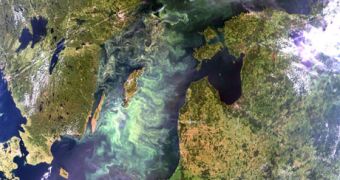The toxic cyanobacterium Nodularia spumigena living in the Baltic Sea, has everything it needs to thrive, researchers from the University of Gothenburg concluded: continuous eutrophication of the water and an ever thinner ozone layer.
Cyanobacteria are a type of phytoplankton, and surface blooms have increased in frequency as well as in magnitude, in the Baltic Sea in recent decades.
Researchers are divided on the causes of this: some say that it is because of the eutrophication (an excess of nutrients present in the water) caused by human emissions of nitrogen and phosphorus, for the past 150 years.
Others claim that this has nothing to do with it and, after analyzing the bottom sediments of the Baltic Sea, they say that this is a perfectly natural phenomenon, that has been going on for over 7,000 years, and it is simply caused by climate variations.
The certainty is that different species of nitrogen-fixing cyanobacteria bloom at different times, like Aphanizomenon species, that tend to bloom from May to June, but from July to August the toxic Nodularia spumigena dominates the waters, for as long as the surface of the sea is warm and still.
It produces a hepatotoxin called nodularin, which attacks the liver, this is why livestock and dogs around the Baltic Sea have died after drinking large amounts of toxic water during blooms.
Malin Mohlin from the University of Gothenburg’s Department of Marine Ecology, explained that “there are several species of cyanobacteria, or blue-green algae, that can form surface blooms in the Baltic Sea.
“Which species ends up dominating a bloom depends partly on how they deal with an increased amount of UV light and a shortage of nutrients.
“Nodularia spumigena is most toxic when there is little nitrogen in the water but sufficient amounts of phosphorus.”
This is why wastewater treatment processes that only remove nitrogen can favor cyanobacterial blooms and make them even more toxic.
A logical measure against this would be the clearing of both nitrogen and phosphorus from wastewater, AlphaGalileo reports.
Mohlin says that July is when the Nodularia spumigena can be expected to be most toxic, due to a larger quantity of phosphorus in the water (compared to nitrogen)
And even if the cyanobacteria are not yet floating on the surface, they can be found deeper in the water where they have not yet been exposed to UV light.

 14 DAY TRIAL //
14 DAY TRIAL //